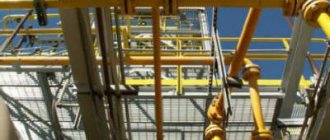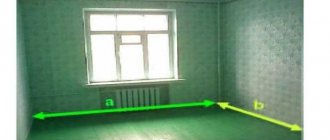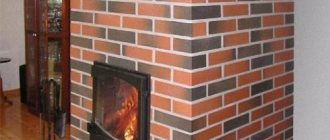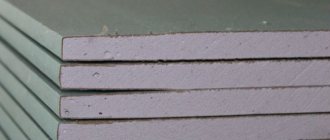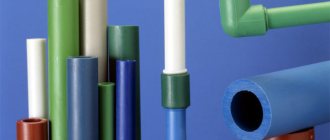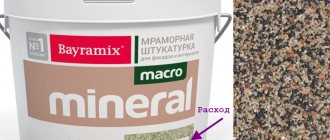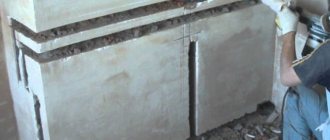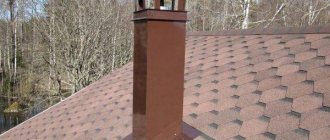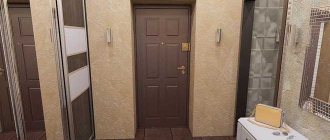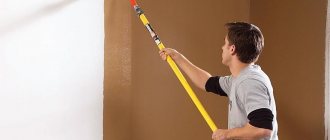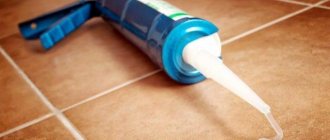The term “pipe surface area” from a geometry course becomes vitally important during installation and construction. The label of a paint can contains direct or indirect information about the consumption of material per 1 square meter of surface.
Calculation of the surface area of the floor, walls and doors is performed by multiplying the length of the object by the width. Measuring the dimensions of the room with a tape measure will give the master useful information for calculations.
But, in addition to rectangular surfaces, the house has water, heat and gas networks. Calculating the surface area will help determine the financing of an event called “painting pipes.”
Where are volumetric metal elements used?
In Russia, pipes of six classes are produced:
| Product class | Application area |
| 1 | Transporting water and gas under low pressure. Manufacturing of auxiliary structures in construction. |
| 2 | Transportation of water and gas under high and low pressure |
| 3 | Wiring of units operating at high temperatures and under pressure |
| 4 | Complete set of drilling rigs in an oil field |
| 5 | Load-bearing structural elements of cars, carriages, cranes |
| 6 | Blanks of parts for the mechanical engineering industry: receivers, bearings, injector cylinders. |
The production of metal and plastic products, reinforced concrete and polyvinyl chloride has been established. Given the variety of materials, 90 percent of engineering structures for the passage of water, heat and gas in Russia are made of steel. Metal requires protection against corrosion. To calculate the amount of protective coating, the surface area of the pipe is calculated.
Applying the calculation formula
Information about the squaring of the outer surface of a round figure is necessary for designers, estimators, installers and equipment maintenance and repair specialists, for example, when solving problems:
1. The volume of thermal energy of the “warm floor” structure or heating radiators.
2. Body losses during transportation from the point of delivery to the border of the balance sheet of the networks.
3. The amount of costs for protecting metal from corrosion. The main elements are coated with paint and bitumen varnish. Accurate calculation of the area will prevent inappropriate use of paint.
4. Quantity and cost of insulating material. For example, the distance from the thermal power plant collector to a residential village is 2 kilometers. The length of the residential area is three kilometers. A total of 5 kilometers of backbone networks will require insulating material. The area needs to be calculated without wasting money on the purchase of mineral wool, fiberglass and aluminum foil.
The inside of the pipe is not painted or insulated. But to calculate the speed of water movement, you need to know the internal area. In main water pipelines with a diameter of 1.4 m, the friction of water against the internal walls can be neglected. But on structures with a diameter of 20-30 cm, after 10 years of operation, salt deposits are recorded. Corrosion worsens the condition of the internal walls, and the speed of water flow decreases.
Cylindrical structures
The usual type of overpass is a cylinder with the same diameter at the beginning and end. We will calculate the surface area of the pipe for painting and thermal insulation by mentally sawing the structure lengthwise, we will obtain a rectangle with the parameters:
T – length of the figure, equal to the length of the product.
W – the width of the figure, equal to the circumference of the structure.
The length is measured, the diameter D is marked at the end of the pipe with indelible paint or branding.
The circumference of a cylinder is calculated by multiplying the diameter D by the constant “Pi”. Let us take the number “Pi” accurate to the fifth decimal place as 3.14159. Let's find the area P of the cylindrical pipe.
P = W * T
P = 3.14159 * D * T
For a highway 5 kilometers long and 1.0 m in diameter, the area will need to be painted
3.14159 * 1.0 * 5000 = 15708 sq.m.
The interested reader can create an electronic spreadsheet in EXCEL to calculate the surface area of pipes to be painted, rather than having to constantly pull out a calculator.
Calculation of the outer surface area of the pipe
As in the previous case, you can find the area of the pipe through the diameter. The calculation formula is also quite simple, because the development of the cylinder area is a rectangle, for which the length of one side is equal to the circumference of the outer section, and the second is equal to the length of the pipe section.
Accordingly, the formula for the pipe area is:
S=2πRL=πDL,
where R is the outer radius of the product, D is the outer diameter, L is the longitudinal length of the pipe.
As in the previous case, the calculation must be carried out in the same units (for example, if the pipe diameter is 15 mm and the length is 1.5 m, then when recalculating you need to use either the values of 15 and 1500 mm, or 0.015 and 1.5 m) .
Based on the size of the outer surface area of the pipe, the required amount of coloring materials or heat-insulating substances is calculated.
Detail in the form of a truncated cone
Pipes are used not only with round cross-section, but also with rectangular and oval cross-section. The dimensions of one end may differ from the parameters of the second end, for example, in a pipe in the form of a truncated cone. An example of a truncated cone is an ordinary bucket. The diameter of the bottom of the bucket is smaller than the diameter of the top.
The science of geometry will come to the rescue here too. The standard formula for the surface area of a truncated cone pipe looks like this:
P = 3.14159 * (P + p) * T, where
P – required surface area;
Р – radius of larger diameter;
p – radius of smaller diameter;
T is the length of the product.
The radius is half the diameter. Remember that there are markings on the ends.
Let the pipeline be custom-made with parameters P = 1.0 m and P = 0.8 m. Let us take the length to be 1 kilometer. Then the area of the outer surface of the pipe is:
Mon = 3.1415 * (1.0 + 0.8) * 1000 = 2827 sq.m.
How to calculate the surface area of different pipes
The surface area of the pipe is determined by the formula. Circumference is one of the important geometric quantities. Calculations should be given special attention. To calculate the number of squares of metal pipelines, it is recommended to apply mathematical formulas.
Cylindrical
The calculation is determined by the following formula: S = 2 x π x R x L
π is a constant value, equal to 3.14;
R – radius of the product (in mm);
L is the length indicator (in m).
Precast concrete pipes
To calculate the paint area of cylindrical sewer pipes, the main criterion is the height indicator (H). Calculating square footage is easy using the formula above.
On the video: the volume of a cylinder and its surface area.
Profile
The area of the profile pipe is determined as follows. When calculating the appropriate squares for painting, the formula should be used: S = 2 x H x L + 2 x W x L
H and W are the heights of the two sides;
L – length of profile pipes.
Cone-shaped
It is easy to find out the number of squares for painting pipes of this type using the formula: S = 2 x π x R1 x L + π x (R1 x R1 + R2 x R2)
2 and π are constants;
R1 and R2 are the specified diameter of the smaller and larger circle;
L – denotes the length of the entire element.
Corrugated
It is most difficult to calculate how much material is needed to paint products with this type of surface. For calculations you should determine:
- The rounding radius is A. Let's say it is 3 mm. Using the formula – 2 x π x A we calculate the rounded part, it will be 18.84 mm;
- Vertical projections of length (B) and diameter (D);
- The bevel angle at the very base is E (calculated by multiplying D by 2);
- The height of the corrugation is F, and G is the stretching line of the product.
Next, you will find out the number of folds, the calculated one is obtained by division, that is, the length divided by the step. You can calculate a stretched structure by multiplying the number of folds formed by the length of the corrugation, also in a stretched state.
Calculation of the area of pipe or pipeline to be painted can be found in tables on the Internet, or you can do it yourself. The area of the outer surface of the pipe can be easily taken from reference books, according to the tables placed in them. To determine the external size of the area, you can use the base development method. The diameter obtained from the measurement can be used as a guide when calculating the radius.
Using an online calculator, you can accurately calculate the circumference and squares to be processed, both external and internal bases.
Inner surface of the part
The inner diameter is marked at the end. If there is no factory mark, the diameter inside the pipe “B” is calculated using the formula:
B = D – 2*C, where C is the wall thickness.
Next, the calculation of the area of the inner surface of the pipe is carried out according to the already known formula, only instead of the parameter D, the parameter “B” is used.
Pv = 3.1415 * V * T.
Let's return to the considered example with a cylinder. To the known parameters we add wall thickness C = 0.1 m. Then the surface area of the inner cone is equal to
Pv = 3.14159 * (1.0 – 0.1*2) * 5000 = 12566 sq.m.
Heat preservation
Insulation of heating pipes reduces heat loss not only in the central line, but also in the bulk room, where the route between the heating boiler and living rooms passes through cold auxiliary rooms.
The difference between insulation materials in terms of thermal conductivity and installation method requires selection taking into account the installation location and the properties of the material. Manufacturers offer several types of insulating element:
- glass wool in cut rolls; after wrapping it around the pipe, it is tightened with wire and covered on top with aluminum foil or roofing felt;
- basalt wool in plates; installation technology similar to glass wool;
- flexible pipe made of foamed foil polyethylene with a cut along the product for installation; used for internal engineering networks;
- Liquid thermal insulation is used on already laid pipelines, when there is no room for maneuver with other materials.
- polystyrene foam in the form of two detachable pipe halves; during installation, the shell halves are put on the pipe, aligned and secured with construction tape; Foam insulation is used repeatedly.
The square footage of the covering material depends on the thickness of the insulation. The formula for the surface area of thermal insulation in the case under consideration looks like this:
P = 3.14159 * D * T * K, where
D – outer diameter of the pipe;
T – pipe length;
K is a variable correction factor for the thickness of the insulation.
Construction calculators have been developed to calculate the area of insulation.
Table of paint area for water and gas pipes
The table contains information about the painting area per 1 m of pipeline (in sq. m) for a given insulation thickness. In order to use the data provided by the table, the outer and inner diameters must be known. All this data can be obtained by performing calculations using the formulas that were indicated above in this material.
The table contains information about the painting area per 1 m of pipeline (in sq. m) for a given insulation thickness.
The table contains data that indicates that the painting area per 1 sq. m of pipeline will depend on the thickness of the insulating layer in mm. It can be 30, 40, 50, 60 and 70 mm. In addition, the table contains information regarding the outer diameter (in inches), outer diameter (in mm) and inner diameter (in mm).
